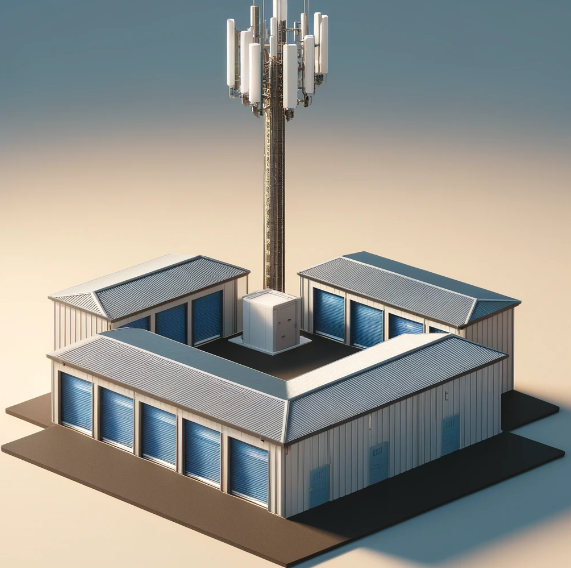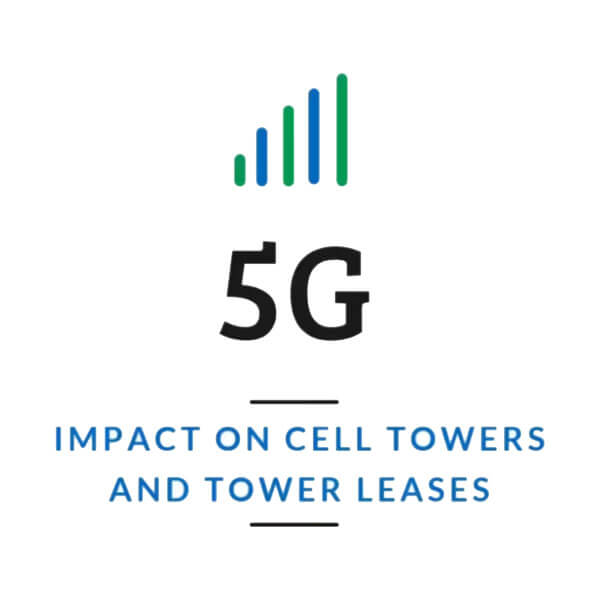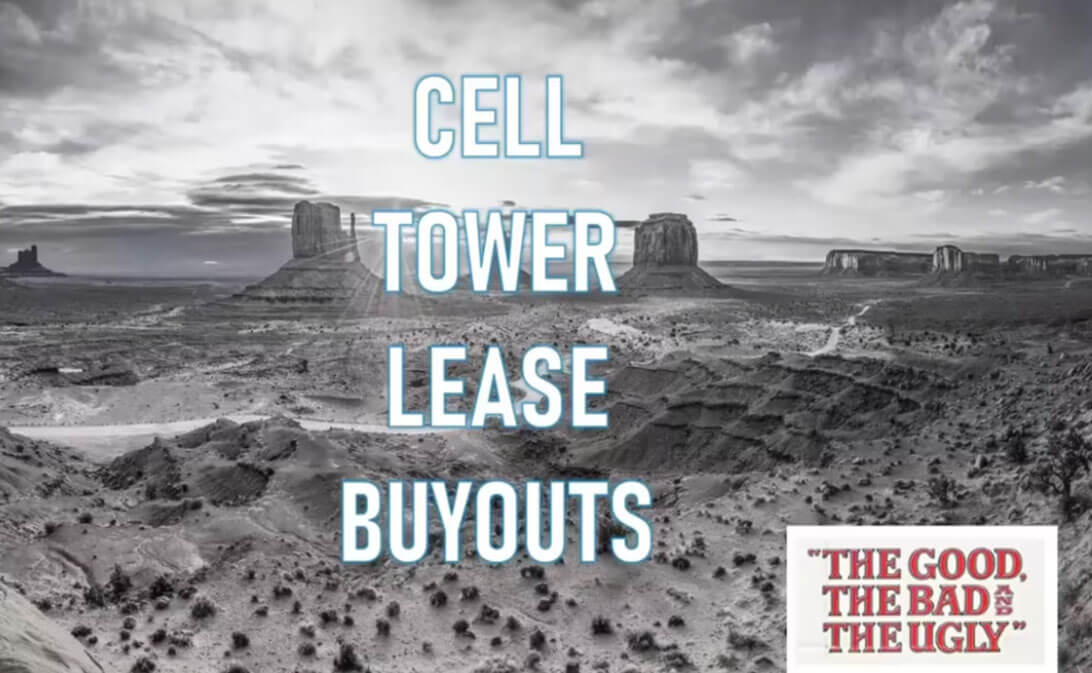6 Types of Cell Tower Leases
Types Of Cell Tower Leases
Steel in the Air has served over 4,000 clients and reviewed over 13,000 wireless leases. Since the wireless telecom industry rarely publicizes information on their cell site leases, we find that many of our clients are less than sufficiently informed about industry dynamics, their rights as property owners, or the fact that there are several types of wireless leases. In an effort to be a valuable public resource, we wrote this page to bring some light to the different types of leases.
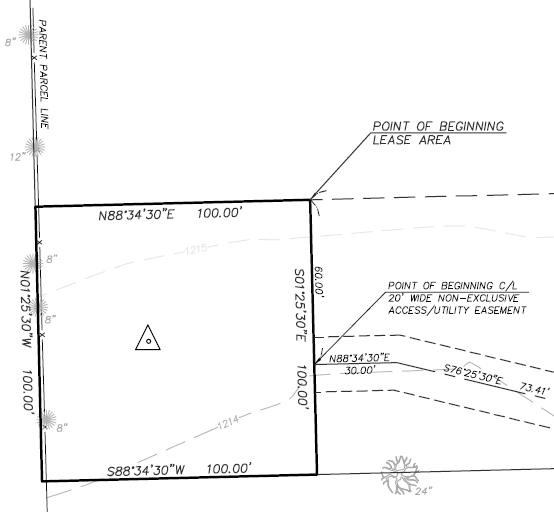
When you think of a cell tower lease, you are probably thinking of what we refer to as a ground lease. This is the lease agreement between the property owner and the company (wireless carrier or tower company) that erects the tower on the property. The ground lease specifies the actual territorial boundaries that will be utilized when erecting the tower and usually includes and access and utility easement to and from the lease area. This initial ground lease is extremely important as it contains many variables other than just lease rate (such as lease size, permitted use, and length of term) that set the stage for future possibilities, and income at the site. The below is an example of a survey showing a 100’x100’ ground lease with a 20’ wide non-exclusive access and utility easement (tower location is shown the triangle in the middle of the lease area).
Contact Us
Lease Expansions occur when the original tenant wants to expand upon the agreed-upon boundaries of the leased ground space in order to install additional equipment – or to provide space to a new tenant (a separate wireless carrier) who will be collocating on the premises. Lease expansions are modifications or amendments to the existing ground lease. When a landowner is being asked for a lease expansion it is important to research the reason for the expansion and understand the value of the lease area that is being requested. It is highly unlikely that a lease expansion would be needed for a 100’x100’ lease area. However, for illustrative purposes, please see the below example of a lease expansion of the original lease (showing a 35’x100’ expansion to the north end of the original lease area).
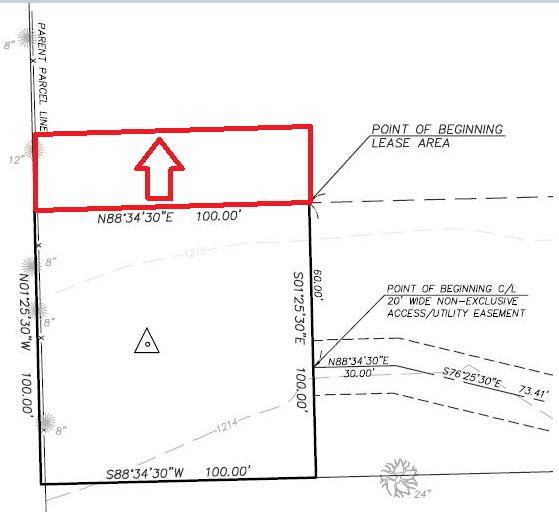
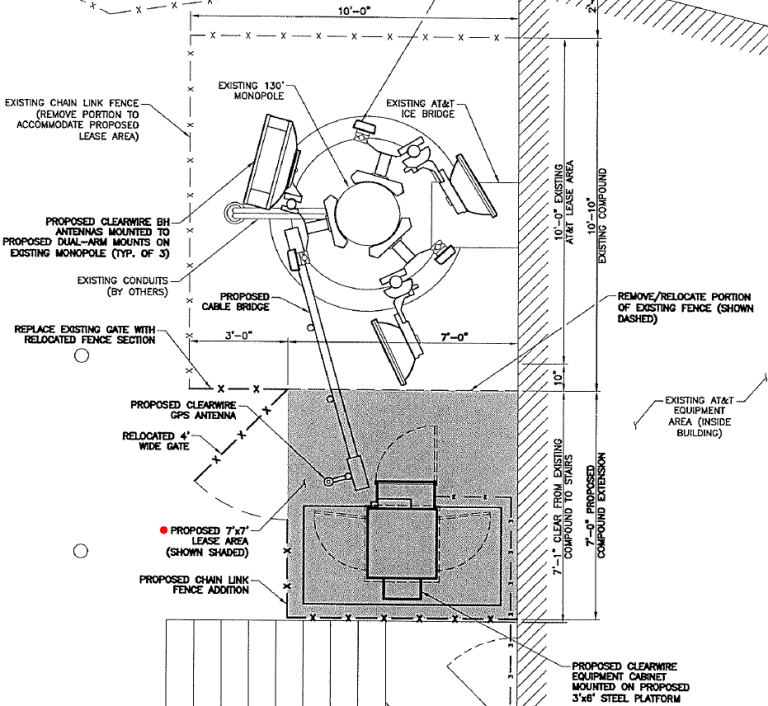
Rather than a modification or amendment to an existing ground lease, an Additional Ground Space Lease is a new lease (almost always) with a different party than the Lessee of the original ground lease. This type of agreement is most often with a carrier that needs initial or additional space at the site. For example, say you are already party to a ground lease with Crown Castle that includes the 10’x10’ lease area for the tower and just enough lease area that is sufficient for AT&T’s equipment. If an additional carrier (Clearwire/Sprint in the below example) would like to utilize the same tower, they would need to lease additional ground space, since there currently isn’t available room in the ground lease area to add their equipment. In this case Clearwire/Sprint will then contact you, the property owner, to negotiate a new separate ground space lease, as a result of which, you will receive additional rent. Please see the below site plan showing the 7’x7’ Additional Ground Space lease area that is being proposed by Clearwire/Sprint (noted with a red dot and shaded in this example).
Also known as a “tenant lease,” the Tower Collocation Lease is a contract between the wireless carrier and the tower owner, who can either be another wireless carrier or a tower company. Typically, the tower owner is already engaged in a ground lease with the property owner, although sometimes the tower owner owns the property upon which the tower is built. When wireless carriers collocate on an existing tower, they make payments to the tower owner directly in exchange for utilizing the tower and ground space. If additional ground space is required, then the wireless carrier would enter into an additional ground space lease with the landowner, in addition to the collocation lease with the tower owner. Please see the below sketch showing the same site as above in which Clearwire/Sprint is proposing equipment on the tower (noted with red dots). You can also see the carrier’s proposed ground equipment to be in the 7’x7’ additional ground space lease (noted with a blue dot).
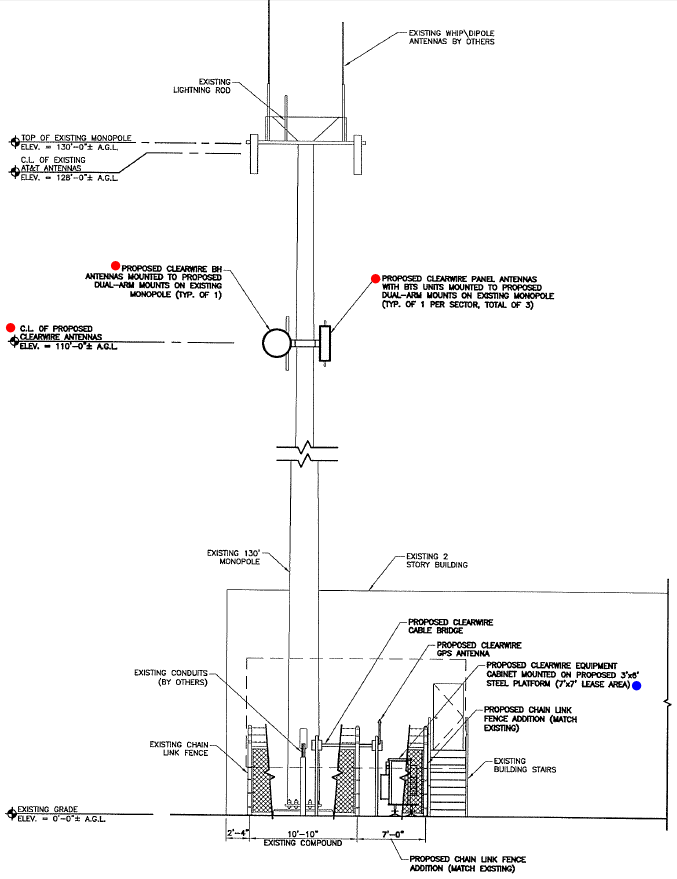
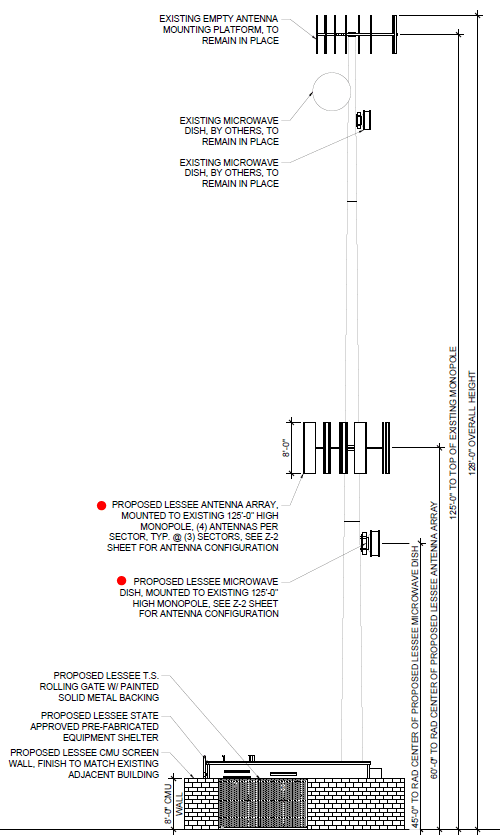
Lastly, just for additional illustration please see one more example of a proposed tower collocation, where the carrier is proposing to install equipment on the tower (noted with red dots) and the ground space. In this example the tower owner controls sufficient ground space and so an additional ground space lease is not required.
The rooftop lease is an agreement between a building owner and a wireless carrier. Similar to a collocation lease, rooftop leases occur when wireless carriers do not own the structure upon which they install antennas and equipment on.
The difference is the structure itself. Towers are built upon a given ground space; antennas are placed on rooftops. Many of our clients have begun discussions by stating they have a cell tower on their rooftop, when they actually mean they have cellular antennas. In the rare case, however, they are correct, and there actually is a cell tower on the roof. (Please see our article, Types of Cell Towers).
For example, US Cellular needs a new site in a densely populated downtown area. Municipal zoning doesn’t permit towers, but there are many tall buildings to choose from. US Cellular approaches you, the building owner, to request access to your rooftop so that it can install antennas on your rooftop, the façade of your building, or (in some cases) inside the building. Additional equipment is also often placed on the rooftop, inside your building, or on the ground next to your building. When a rooftop lease is proposed for your building, it is important to understand why they have chosen your building as well as a rooftop in general. It is also helpful to understand what exactly the carrier is proposing to do, their desired outcome, and the corresponding value of such a lease. Please see the below sketch showing a proposed rooftop site by Verizon. The proposed antenna locations are shown in red while the blue dot notes additional equipment that in a ground space lease area.
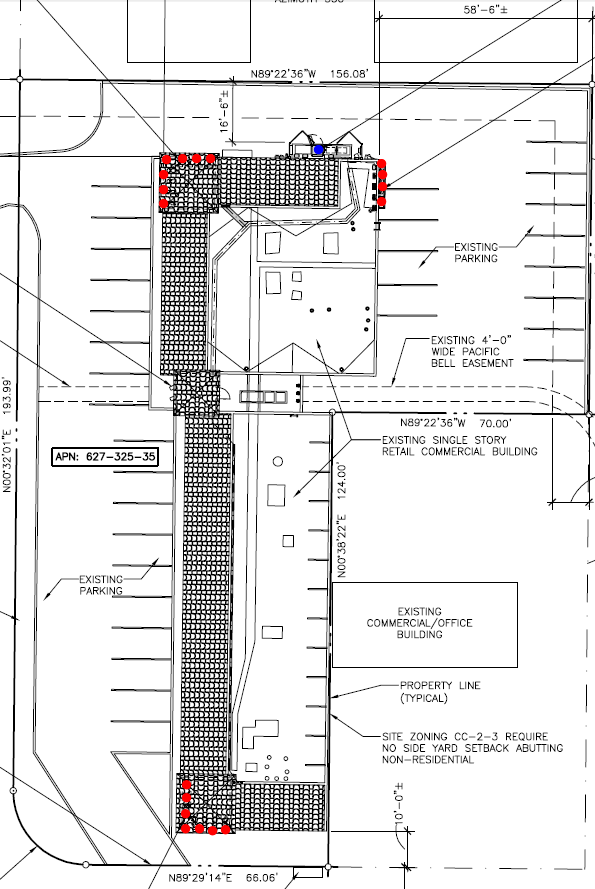
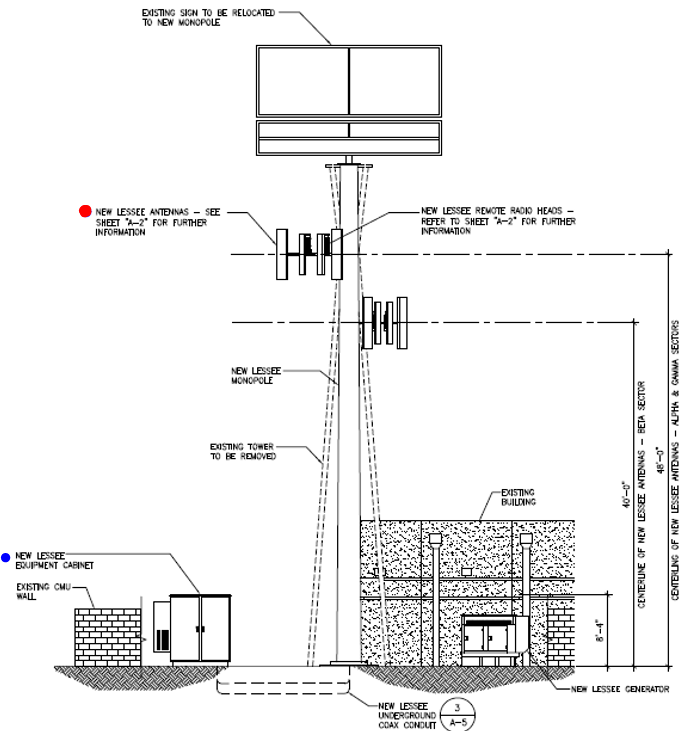
Similar to collocation and rooftop leases, the tenant improvement lease also occurs when wireless carriers seek to install equipment on property they do not own. In this case, they utilize existing structures that were built for a purpose other than supporting wireless equipment. Such structures include water towers, billboards, silos and utility poles.
For example, please see the below Tenant Improvements proposed by Verizon on a billboard/sign. In this case Verizon is looking to enter into a Tenant Improvement Lease with the billboard/sign owner, including the right to place equipment on the ground as well.
As you can see there are multiple types of cell tower and wireless leases and each have their own unique qualities and variables to take note of. However, one thing is similar across the board. Whether you are looking at a proposed Cell Tower Ground Lease, a lease to expand or add ground lease area, or a lease to collocate on your rooftop or existing structure, it is crucial to understand the level of uniqueness of your site, what exactly the carrier is proposing to do, and the use or coverage that they plan to get out of your location. All of this together will help you arrive at the true value of the proposed lease and help to create the most value for you in return. For any type of cellular asset – from property to leases to towers, Steel in the Air is your trusted source. Please contact us for a free initial consultation.

